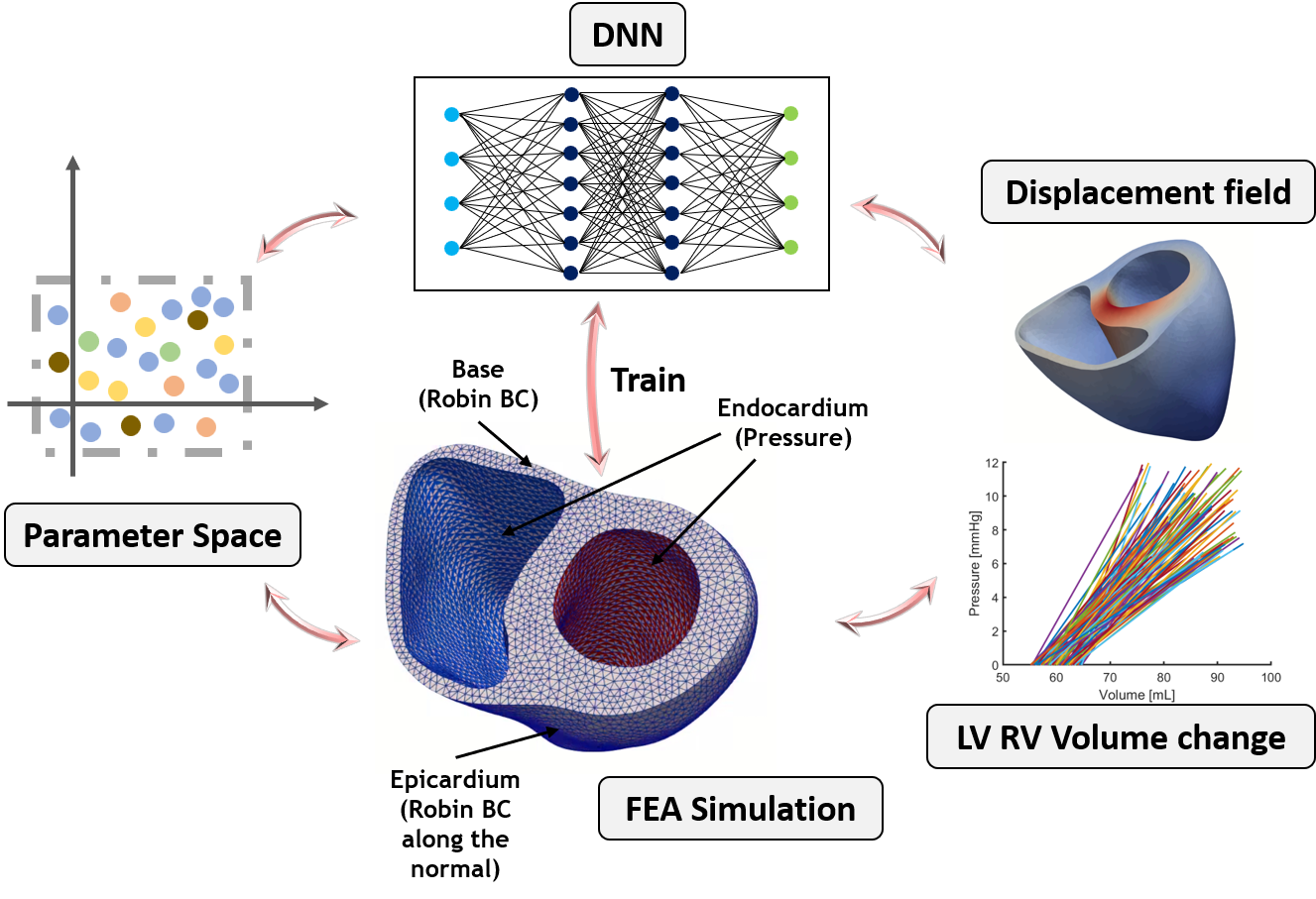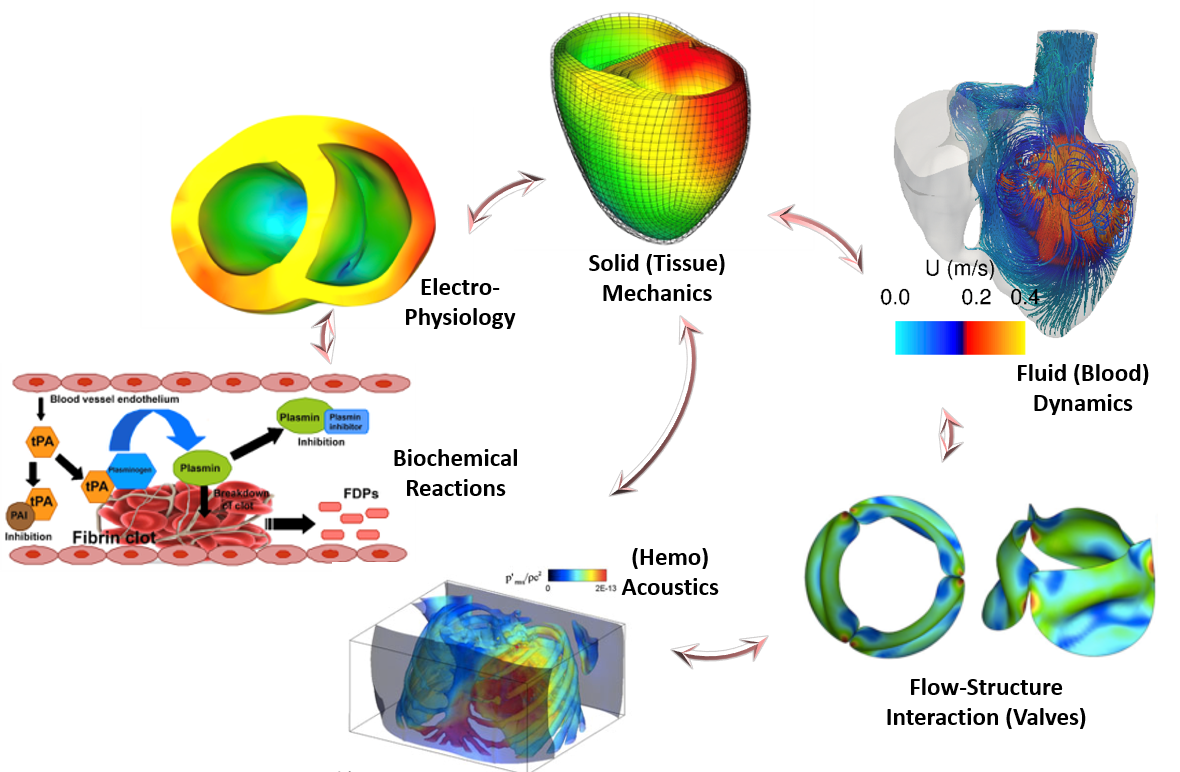Research
Professor Shi's interests include the intersection of experimental, computational, and machine-learning technologies, with a primary focus on soft tissue investigations. This work encompasses various areas, including cardiovascular, reproductive, and gastrointestinal systems, as well as soft robotics.
Deep-learning-based methodology in soft tissue mechanical behavior characterization
Computational models are extensively employed in clinical settings for predicting stress and strain patterns within pathological soft tissues, thereby aiding in disease diagnosis and the planning of surgical interventions. However, traditional computational models are characterized by complexity and time-consuming computations. In contrast, machine learning represents an emerging technology with versatile applications.
Neural networks, in particular, can be regarded as universal function approximators capable of simulating partial differential equations, making them well-suited for modeling the mechanical behavior of soft tissues. By embracing a data-driven methodology through neural networks, it becomes possible to significantly accelerate the simulation of computational models. This promising approach holds the potential to revolutionize clinical applications by expediting the analysis of soft tissue mechanics and, in turn, enhancing healthcare outcomes.

Multiscale multiphysics modeling of the soft tissue
Soft tissues are intricate structures comprised of diverse components, each contributing to their complex functions. For instance, tissues like the uterine cervix and myocardium contain a combination of collagen fibers and muscle fibers, distributed in unique patterns, and they dynamically contract due to electromechanical processes. Furthermore, fluids are ubiquitous within biological systems and often play crucial roles in various biological functions. As a result, the investigation of multiphysics interactions within soft tissues holds great significance.
In this research, I leverage multiscale modeling techniques to bridge the gap between micro-level components and the macroscopic mechanical behavior of soft tissues. This approach allows for the development of a multiphysics model capable of simulating the mechanical responses of soft tissues. By doing so, we gain valuable insights into the intricate interplay among the different constituents of soft tissues. Moreover, this research has the potential to uncover biomarkers that can aid in predicting pathological conditions and inform the design of treatments for soft tissue-related ailments. Additionally, it contributes to the advancement of biomimetic organ replacements and the field of soft robotics, where knowledge of soft tissue behavior is fundamental.
This is a part of our collaborative open-source FEA project with Stanford and Columbia - svFSI https://github.com/SimVascular/svFSI

FEA-based design of piezoelectric-based submarine active robots
Submarine robots have emerged as invaluable tools in fields such as marine biology, oceanography, and geology, enabling the collection of critical data on water properties, marine ecosystems, and the seabed environment. As the demand for enhanced underwater exploration capabilities continues to grow, it becomes imperative to develop innovative solutions that not only improve the efficiency and maneuverability of these robots but also harness cutting-edge materials to enable their active propulsion.
Recent advancements in piezoelectric materials have garnered significant attention due to their exceptional mechanical and electrical properties. These materials have found widespread application in sensors, soft batteries, and transducers, demonstrating remarkable performance. One promising avenue for their utilization lies in the realm of submarine robotics, where they hold the potential to drive active movement by mimicking the contractile behavior of muscles.
Efficiency in propulsion, energy consumption, and maneuverability is paramount for the success of submarine robots. Finite Element Analysis (FEA) stands as a powerful tool in achieving these goals by allowing for the simulation of fluid dynamics and hydrodynamics. Through FEA, optimization of the robot's shape, propeller design, and control systems can be achieved, ultimately resulting in enhanced performance and energy efficiency.
In this research, we delve into the realm of FEA-based design, focusing on the integration of piezoelectric materials in the development of innovative submarine robots. By combining the prowess of FEA with the potential of piezoelectric actuators, we aim to revolutionize underwater exploration by creating highly efficient, agile, and actively-propelled robotic systems.
Collaboration
Professor Vijay Vedula - Columbia University https://www.me.columbia.edu/faculty/vijay-vedula
Professor Kristin Myers - Columbia University https://kristinmyerscolumbia.com/
Professor Anand Jain - Emory University https://med.emory.edu/directory/profile/?u=AJAIN31
Professor Hai Dong - Emory University https://med.emory.edu/directory/profile/?u=HDONG30
Professor Alison Marsden - Stanford University https://cbcl.stanford.edu/
Professor Yu Gan - Stevens Institute of Technology https://www.stevens.edu/profile/ygan5









